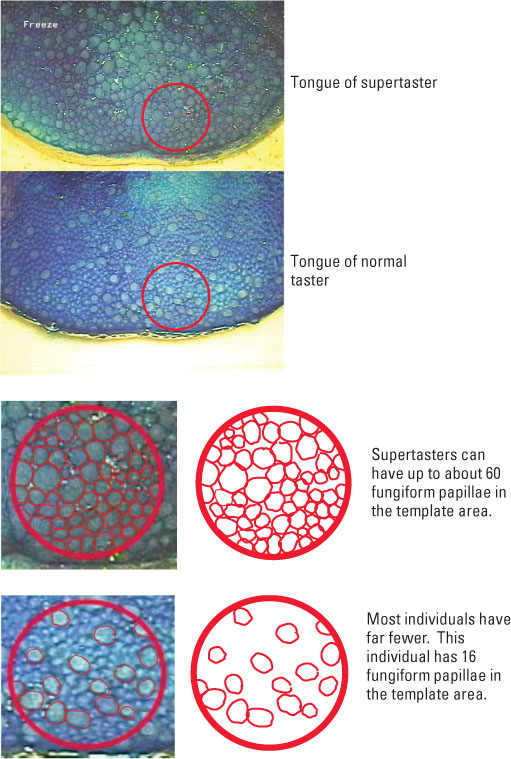7.4 Taste
Some insects have taste receptors on their feet, which allow them to taste what they are walking on. Fish have taste receptors not just in their mouths but all over their bodies (Hara, 1994). They can taste their prey before they see it, and they use taste to help them track it down. For us and other mammals, taste has a more limited but still valuable function. Our taste receptors exist only in our mouths, and their function is to help us decide whether a particular substance is good or bad to eat.
Anatomy and Physiology of Taste
13
How does transduction generally occur in taste?
The receptors for taste are found on specialized taste receptor cells, not directly on the sensory neurons (unlike the case for smell). These cells exist in spherical structures called taste buds. Each bud contains between 50 and 100 receptor cells, arranged something like segments in an orange (see Figure 7.6). Most people have between 2,000 and 10,000 taste buds, about two-thirds of which are on the tongue and the rest of which are on the roof of the mouth and in the opening of the throat (Herness & Gilbertson, 1999). People who have more taste buds are typically more sensitive to tastes—especially to bitter tastes—than are people who have fewer taste buds (Bartoshuk & Beauchamp, 1994).

To be tasted, a chemical substance must first dissolve in saliva and come into contact with the sensitive ends of appropriate taste receptor cells, where it triggers electrical changes that result in action potentials, first in the taste receptor cells and then, by synaptic transmission, in sensory neurons that run to the brain (see Figure 7.6). The specifics of the transduction mechanism vary from one type of taste receptor cell to another.
Five Primary Tastes, Five Types of Receptor Cells
14
What are the five primary tastes? How, in general, does transduction occur in taste receptor cells?
For many years Western scientists believed that in humans (and other mammals) taste receptor cells were of just four types—sweet, salty, sour, and bitter. Every taste, it was believed, could be understood as a combination of those four primary tastes. Japanese scientists, in contrast, generally spoke of five primary tastes—the four just mentioned plus umami, which, loosely translated, means “savory” or “delicious” (Kurihara & Kashiwayanagi, 1998). Umami, they held, is a unique taste, unmatched by any combination of the other primary tastes, and is a major contributor to the taste of many natural foods, especially those that are high in protein, such as meats, fish, and cheese. Umami is also the taste produced by monosodium glutamate (MSG), an amino acid frequently used as a flavor enhancer in Asian cuisine. Taste researchers have recently identified distinct receptor cells and brain areas responsive to MSG, and now even Western taste specialists generally write of five rather than four primary tastes and types of taste receptor cells (Scott, 2012; Shadan, 2009).
261
Taste Areas in the Brain
Taste sensory neurons have strong connections (via several way stations) to the limbic system and cerebral cortex. The connections to the primary taste area of the cortex (located largely in the insula, which is buried in the central fissure that separates the temporal and parietal lobes) are arranged in such a way that different sets of neurons are selectively responsive to each of the five basic categories of taste stimuli (Kobayashi, 2006; Rolls, 2004). People with extensive damage to this area lose their conscious experience of taste (Pritchard, 1991), and artificial stimulation here produces experiences of taste in the absence of any stimuli on the tongue (Penfield & Faulk, 1955). The primary taste area in turn sends connections to several other areas of the cortex, including the orbitofrontal cortex, where, as mentioned in the section on smell, neural connections for taste and smell intermingle and enable us to experience the mixed taste–smell sensation called flavor.

An Evolutionary Account of Taste Quality
15
From an evolutionary perspective, (a) what is the function of each of the primary tastes, (b) why do so many chemically diverse substances taste bitter, and (c) why does bitter sensation increase in women during pregnancy?
The purpose of taste is to motivate us to eat some substances and avoid eating others. Generally speaking, salty (at low to moderate intensity), sweet, and umami are pleasant tastes; in the course of evolution, they became attached to substances that are good for us, or at least were good for our evolutionary ancestors, given their nutritional needs and the environment in which they had to meet those needs. A certain amount of salt intake is needed to maintain a proper salt balance in bodily fluids. Sugars, in fruits and other natural foodstuffs, were a valuable source of energy to our evolutionary ancestors. Protein (the main natural source of umami flavor) is essential for building and restoring tissues. Our ability to taste and enjoy salt, sugars, and proteins is part of the mechanism that helps ensure that we consume adequate amounts of these nutrients.
Still speaking generally, sour and bitter are unpleasant experiences, which natural selection has attached to certain substances that are bad for us. Bacterial decay produces acidic compounds. Since decaying substances can cause disease when eaten, natural selection produced a taste system that experiences most acids as unpleasant (sour). Many bitter-tasting plants (hemlock is a famous example) and some animals (notably some species of caterpillars), as part of their own evolution, have concentrated toxic substances into their tissues—substances that can harm or kill animals that eat them. As a consequence, our ancestors evolved a taste system that experiences most of those toxic substances as unpleasant (bitter).
Evolution of the Ability to Taste Toxic Substances as Bitter

To pursue this evolutionary line of thinking, let’s consider further the relationship between bitter taste and poisons. A wide variety of chemical substances all taste bitter to us, even though they may be very different chemically from one another, because each is able to bind to one or another of the approximately 25 different types of receptor sites located on bitter receptor cells (Behrens et al., 2007). The receptor sites are specialized protein molecules that bind certain molecules that come into contact with them. The binding of any substance to these sites triggers a chemical change in the cell. This chemical change results in action potentials in the sensory neurons and, ultimately, activity in areas of the brain that produce the bitter sensation.
262
From an evolutionary perspective it is no accident that there are so many different types of receptor sites on bitter receptor cells and that most of the chemicals they bind are either poisonous to us or chemically similar to poisons. Imagine an early species of animal that ate plants, some of which contain substance A, a poison that kills by interfering with the animal’s respiratory system. Any mutations affecting the taste system of an individual of this species in such a way as to make it dislike the taste of A would promote that individual’s survival and reproduction, so those new A-rejecting genes would multiply from generation to generation.
Individuals having the new genes would experience substance A as having a negative, bitter taste and would avoid it; but they would continue to eat plants that contain another poison, substance B, which kills animals by paralyzing the muscular system. Because B is an entirely different compound from A, it does not attach to the A receptors on the taste cells that trigger bitterness, so the animals have no sensory grounds for avoiding it. Now imagine a single mutation, which results in a new variety of receptor protein on the surface of bitter taste cells, a protein that can bind molecules of B. The animal with this mutation would experience the same bitter sensation upon eating leaves containing B as it experiences when eating leaves containing A, and it would avoid both of them. It would be more likely to survive and send progeny into the next generation than would other members of the species, and many of those progeny would inherit the new gene.
Extending this scenario, you can imagine how natural selection might have produced modern mammals that have bitter taste cells containing many different types of receptor proteins, able collectively to bind molecules of most toxic substances found in plants and other potential foods. We can’t go back and prove with certainty that this is how the present state of affairs relating to bitterness came about, but this account helps make sense of the facts of bitter taste.
Possible Explanation of Sex and Age Differences in Bitter Sensitivity
Although avoidance of bitter-tasting foods is generally adaptive, too much avoidance of them is not. Plants protect themselves from being eaten not just by producing truly poisonous substances, but also by producing nonpoisonous substances that are sufficiently similar to poisons that they bind to bitter taste receptors and produce bitter taste. Individuals that avoided all bitter tastes would lose the nutritional value of plants that taste bitter but are safe to eat. Through observation and experience, people and other plant-eating animals can learn to eat and enjoy bitter foods that have no toxins or low levels of toxins.
Among humans, women are generally more sensitive to bitter taste than are men. In fact, about 35 percent of women are said to be “supertasters,” with a special sensitivity to bitter taste. This is compared to about 15 percent of men, and about 25 percent of people cannot taste the specific bitter chemical at all (non-tasters). Supertasting (and the lack of it) seems to be controlled by a single dominant gene, with supertasters having an increased number of fungiform papillae on their tongues and (Bartoshuk et al., 1994, 1996) (see Figure 7.7).

Although women are generally more sensitive to bitter taste than men, many women become increasingly sensitive to it during the first 3 months of pregnancy (Duffy & Bartoshuk, 1996; Nordin et al., 2004). A possible reason is found in evidence that human fetuses are highly subject to damage by poisons, especially during the first 3 months of their development (Profet, 1992). With the stakes being survival of offspring, the value of avoiding even mild toxins increases.
263
Young children also appear to be highly sensitive to bitter tastes (Cowart, 1981), which may help explain why it is so difficult to get them to eat nutritious but bitter-tasting greens, such as spinach or Brussels sprouts. Children’s extra sensitivity to bitterness may help protect them from eating poisonous materials during their early development, before they have learned what is safe to eat and what is not.
SECTION REVIEW
Taste is a chemical sense that helps us decide what is good or bad to eat.
Basic Facts of Taste
- Human taste receptors are specialized cells contained in taste buds on the tongue and other parts of the mouth and throat.
- Five types of taste receptors have been identified, which correspond to five primary tastes—sweet, salty, sour, bitter, and umami.
- Taste receptors can trigger neural impulses in taste sensory neurons, which send input to the primary taste area in the frontal lobe and to other parts of the brain.
Evolution and Taste Quality
- Through evolution, we have generally come to experience beneficial nutrients as pleasant in taste (sweet, salty, or umami) and harmful substances as unpleasant (sour or bitter).
- Bitter receptor cells evolved to respond to many chemically varied substances that are poisonous or chemically similar to poisons.
- Natural selection may explain why children and women, especially pregnant women, are particularly sensitive to bitter tastes.
264